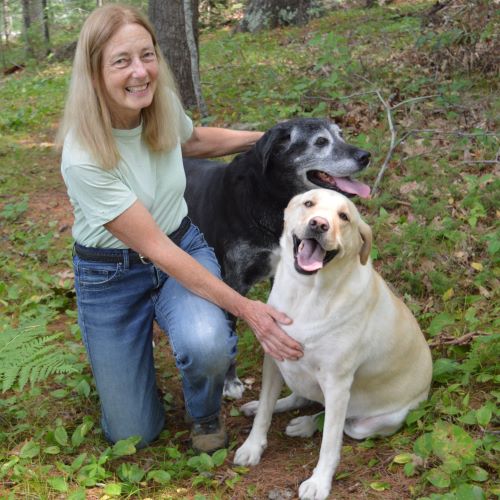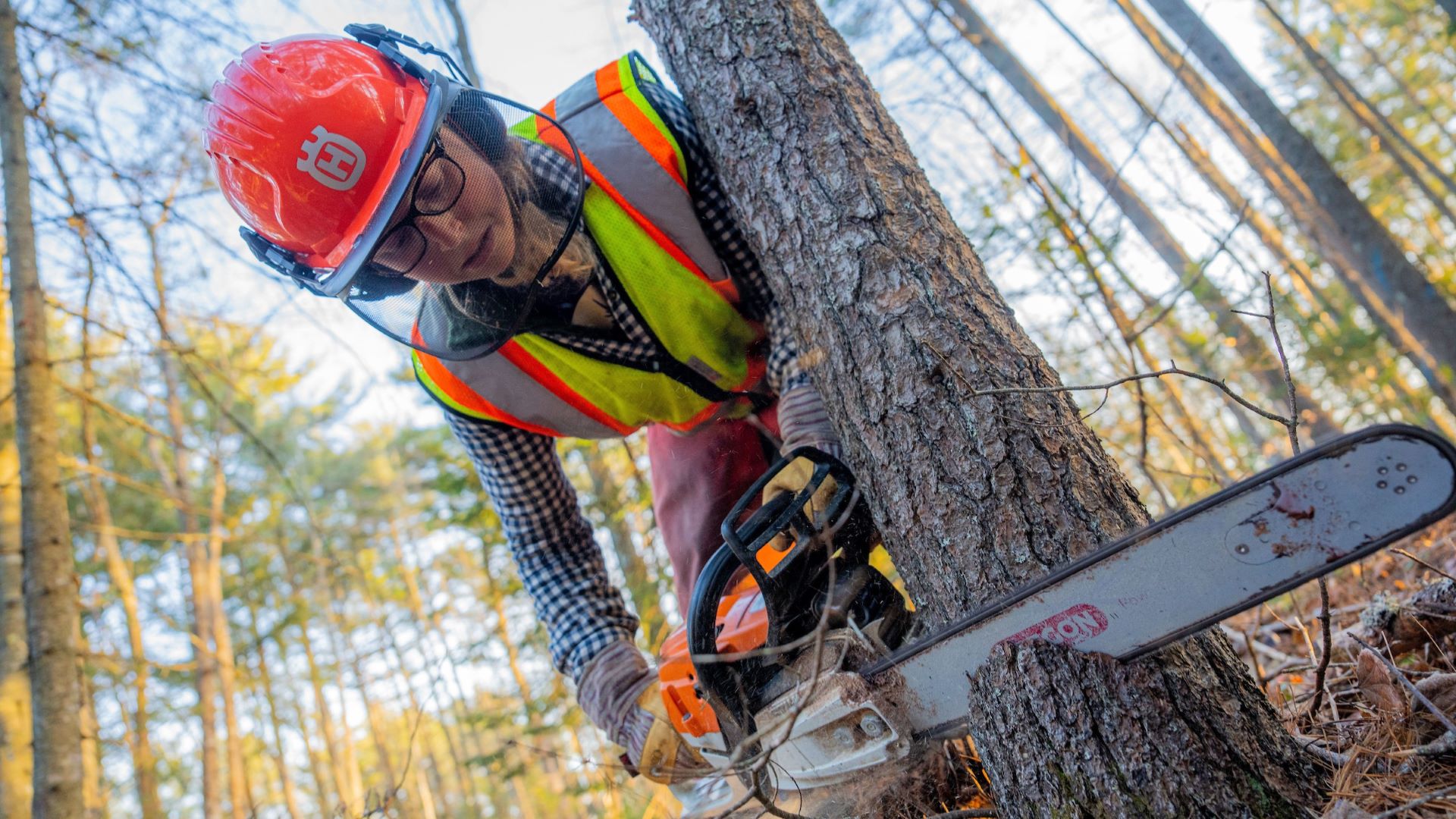Elisa Schine, a graduate student in forestry at the University of Maine, is accustomed to being in predominantly male academic and professional settings. Although forestry has become much more inclusive of women during the past several decades, it remains, after all, a majority male profession.
So Schine was excited to be just one in a crowd of mostly women foresters and other forest sector professionals who attended the inaugural Women’s Forest Congress, held this past October in Minneapolis.
This event was something new: a major national gathering focused on issues related to women’s roles in forests’ future, including strategies to increase recruitment, retention, and advancement of women in the forest sector.
“It was amazing for me, new to the profession, to be in a building of [so many] women and nonbinary people who were just talking about how to diversify the forest sector, how to amplify voices that haven’t been in the past, and how that might benefit everybody — not just the women — who are trying to get into the business,” Schine said. “I just thought it was an incredible opportunity to see that side of this world that I’m getting into.”
How much the culture of forestry has changed for women, and how it’s continuing to change is, of course, variable across regions, and specific to workplace and individual circumstances.
But without dismissing challenges that remain, the three Maine foresters profiled here describe an industry that has changed — and is continuing to evolve — for the better, thanks to active efforts of people in the profession, especially trailblazing women who began their careers in the 1960s, ’70s and ’80s.
Today, female foresters are rising to the top of their profession in government, private industry, and nongovernmental organizations. They are recognized by peers and are taking on leadership roles. Perhaps most important, they offer models, encouragement, and mentoring to younger women.
The three foresters profiled here include Schine; Barrie Brusila, a highly regarded Maine forester, now winding up a long and successful career; and, between them, Maren Granstrom, who at 31 has completed a comprehensive apprenticeship under Brusila’s watchful eye and soon will be taking over her business.
The “Lady Forester”
“I can almost count on one hand the number of female consultants in Maine,” Barbara “Barrie” Brusila wrote in a 1997 article published in the Journal of Forestry. “In our area, a logger will refer to me as the ‘lady forester’ and people know exactly who he’s talking about.”
Brusila has worked as a consultant forester since 1980 and has operated Mid-Maine Forestry with her husband since 1995. She also manages a 60-acre family woodlot.
Soon to retire, she is a prominent figure in Maine forestry circles.

In 2021, the Society of American Foresters named her one of that year’s Presidential Field Forester Award recipients, a distinction reserved for foresters “who have displayed uncommon talent, skill, and innovative methods to achieve a record of excellence in the application of forest management.”
Although Brusila appreciates the recognition, she said that she isn’t comfortable with public accolades. She still remembers when surprise and skepticism about her abilities were more common responses than respect.
“I was a young, female whipper-snapper,” she recalls of her first post-college job in 1980, working for a woodlot owners’ cooperative in Dover-Foxcroft for $4 an hour. “Initially, the old-time loggers were taken aback. But what matters to loggers is how I mark trees and the ease of our working relationship, and I did a good job.”
Because those years predated cell phones, Brusila often found herself having to call loggers after work or early in the morning.
“The logger’s wife would answer the phone,” she says with a laugh. “And in my young-girl voice I’d ask for the logger and she’d say, ‘Well, this is his wife and what do you want?’ But they got over it, and ended up being very supportive.”
Brusila acknowledges that her early skirmishes with discrimination do not represent the extent of challenges other female foresters encountered at the time and unfortunately still sometimes encounter to this day.
Throughout her career, she’s heard stories from colleagues whose experiences have included sexual harassment — and she has heard how corporate cultures can amplify individual bias and stereotypes.
“If you are young and female, you’re starting out at the bottom of the pecking order,” she said. “It makes you more vulnerable. I never worked for a big company, and that gave me a lot more freedom and made me less subject to things like harassment.”
That independence also enabled her to find her voice in the industry. As a woman and a forester with “ecological” leanings, she quickly discovered that her point of view wasn’t always welcome in professional forestry gatherings.
She admits to having felt intimidated and outnumbered on such occasions.
But in 1997, she helped to found the Forest Stewards Guild, a rewarding experience that encouraged her to seek out more leadership roles. During the following years, she burnished her advocacy and organizing credentials as she pushed for forest-first principles and practices, and sought to create new opportunities for education and hands-on learning for forestry students and newly minted foresters.
“What’s really become important to me is mentoring,” said Brusila, who helped organize a July 2022 meeting of the multistate Women Foresters Collaborative, which gathered a group of about three dozen women for two days of workshops, talks, and tours at the Hidden Valley Nature Center in Jefferson. She’s also devoted time to educational work — in schools, summer camps, and other environments — where she can show young people what’s possible.
Her message to girls who express an interest in following in her footsteps?
“You don’t need to be a big-muscle person,” she said. “Just a desire to be outdoors and on your feet for long periods of time.”
Following in their footsteps
Not all foresters know from childhood that they’re destined to work in the woods.
Appleton resident Maren Granstrom spent her first few years after college working in the communications field, and despite having grown up in Vermont, had never really considered forestry as a possible career choice. In fact, she didn’t even realize it could be a career.
“I met a friend of a friend who was wrapping up his master’s in forestry and I just kind of had this light bulb moment that forestry existed as a profession,” she recalled. “Which is kind of funny because I’d grown up spending a lot of time in the woods. And some of my parents’ friends were foresters. But I never really realized that it was something that I could do for work.”
After taking time to explore her options, Granstrom announced to friends and family that she was leaving her office job with a Maine nonprofit to return to school in pursuit of a graduate degree in forestry. Her friends chipped in to buy her a chainsaw.
“They assumed I was going to be a logger,” she said, laughing, still amused by their confusion. “But honestly, I’ve gotten a lot of use out of that chainsaw.”
Today, Granstrom finds herself in a profession in which women role models — if not plentiful — are visible. During graduate school, two advisors — Mindy Crandall and Laura Kenefic — inspired her to excel. “[They are] both really awesome women and kind of an incredible introduction to women in forestry,” Granstrom said. Now, as an emerging professional, she’s been working with Barrie Brusila and is set to take over Mid-Maine Forestry when Brusila retires later this year.
Having such mentors has been critical to her progress, Granstrom said, because if girls never get to see women in a profession, it is almost impossible to imagine themselves in that role.
“As someone who worked in media,” she said, “I know it’s important how people are portrayed. When I was growing up, if you asked anyone to draw a picture of a hunter, I guarantee you everybody would’ve drawn a male hunter. But I’ve been hunting for a few years now and when I receive the weekly email from Maine Fish and Wildlife, there’s almost always a picture of a woman hunter in it. And I’m sure that’s a very conscious effort.”
Granstrom has faced little in the way of gender bias or prejudice in her work, and she credits the generation of women before her for clearing the path. At the July 2022 Women Foresters Collaborative, she gained a fuller appreciation of the barriers that the previous generation had confronted.
“Among the 35 or so women there, those in the older generation were sharing how things had been pretty rough when they were starting,” she explained. “And I’ve never really had to go through that. I’ve never felt uncomfortable or slighted. I think that’s partly because things are changing, and there are just a lot more women in the field today.”
A fresh start
Elisa Schine knows she has made the move from artisanal canoe-building to professional forestry at an auspicious moment in Maine’s natural resource sector.
Today, some of the most powerful decision-makers — the governor, the commissioner of the Department of Inland Fisheries & Wildlife, the commissioner of the Department of Agriculture, Conservation and Forestry, and the director of the Maine Forest Service — are all women.
“Those women who are leaders are also making their areas more accessible to everyone,” said Schine, who has just completed her first year of coursework toward a Master of Forestry degree at the University of Maine.
Schine believes there’s an economic imperative to improving equity and inclusivity within the field of natural resource management. Forestry and other professions are facing a workforce shortage and need to find ways to expand their labor and leadership pool.
It’s a lesson Schine learned firsthand in her days as an apprentice canoe-builder. “There’s a pattern in these traditional occupations, in that people are always thinking their traditions are dying,” she said. “So when a young person expresses any interest at all in the work, everyone gets excited.”
Schine found her way from canoe-building to forestry when she went out to source raw materials with her mentor Rollin Thurlow of Northwoods Canoe Company in Atkinson.
“We made a lot of trips to sawmills to pick up lumber and talk to the owners,” she recalled. “And so I started getting a sense of the forest product industry in the state, at least from that end. And then I started getting to know more people who were involved in forestry, and I thought it was a great avenue to conserve the forest in Maine – this sort of industry and environmentalist bridge.”
On one of her first school assignments, Schine was tasked with helping to develop a management plan for land owned by a local soil and conservation district. Working with the project’s forester — a woman from nearby Milo — inspired a conversation about creating a women-managed forest. Her excitement rising, Schine suggested that the team ought to “get women contractors to do the harvesting if we needed harvesting.”
With a wry smile, she repeated the deadpan response of the forester: “Yeah, you’re not gonna find any of those.”
Yet Schine is not discouraged. If anything, her participation in the 2022 Women’s Forest Congress has made her even more aware of the need for the forestry industry — as a whole — to actively recruit women, people of color, and workers from diverse social and economic circumstances.
“There’s this incredible resource of potential employees, potential collaborators who are just not being invited in,” Schine said. “And I think, in male-dominated fields, you have to actually invite people in, otherwise they won’t see a place for themselves. That doesn’t seem like a good trajectory to be on.”
As for her own trajectory, with graduation less than a year away, Schine hopes to get into conservation forestry. One possibility is working with smaller woodlot owners as a consulting forester, where she could provide low-impact management options. Another idea is working for a conservation organization or land trust.
“Somehow being part of conserving the North Woods is my goal,” she said. “I think the decisions, and how people make decisions about what happens to their woods, is really interesting. And I think the education piece of being a forester is also valuable.”







